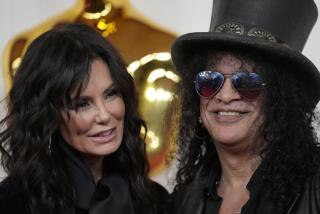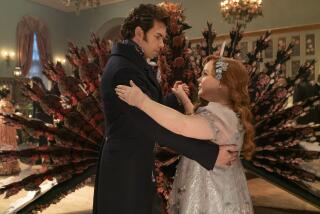Lucille Ball Dies at 77 : The Whole World Loved Lucy During TVâs Golden Age : Suffers Aorta Rupture After Heart Surgery
Lucille Ball, the leggy showgirl, model and B-grade movie queen whose pumpkin-colored hair and genius for comedy made her an icon of televisionâs early years, died early today, a week after undergoing emergency heart surgery. She was 77.
The high-spirited star of âI Love Lucy,â a show that the nation took to its heart as no other and that continues in syndication around the world, died of a ruptured abdominal aorta at Cedars-Sinai Medical Center, hospital spokesman Ronald Wise said.
Miss Ball, who had a heart attack and had throat surgery in 1988, underwent surgery at Cedars-Sinai on April 18 to replace her aorta and aortic valve and had been getting out of bed, eating and even walking around the room in recent days.
Her recovery had seemed so certain that her husband, comedian Gary Morton, had been exchanging jokes with his wife. She had been asking about their white poodle, Tinker.
Wise said the rupture occurred in a portion of the aorta, the main heart artery, far from where the operation was performed.
Since the surgery fans had flooded the hospital with hundreds of cards, telegrams and even facsimile machine messages. Hospital officials said it was the largest outpouring they had ever seen.
âName Brings a Smileâ
Tributes were plentiful and immediate:
âHer red hair, her antics on the screen, her timing and her zest for life made her an American institution,â former President and Nancy Reagan said in a statement. âJust the mention of her name brings a smile. . . . We love Lucy and will miss her deeply.â
âOh, what a blow. What a shame,â said fellow TV clown Dick Van Dyke. âShe didnât deal in jokes, she dealt in human behavior. She was a great physical mime with all the instincts of a Chaplin.â
William S. Paley, chairman of CBS Inc., said from New York: âLucille Ball will always be the first lady of CBS. With âI Love Lucyâ she helped establish television as the nationâs leading entertainment medium. Lucyâs extraordinary ability to light up the screen and brighten our lives is a legacy that will last forever.â
That legacy involved Miss Ball and her late former husband, Cuban band leader Desi Arnaz. They starred regularly from 1951 to 1957 as Lucy and Ricky Ricardo in âI Love Lucy.â The late Vivian Vance and William Frawley played their neighbors, Fred and Ethel Mertz.
The series continued irregularly into the early 1960s.
Talent as Entrepreneur
Her singularity as a comedian was matched by her talent as a show-business entrepreneur. She and Arnaz established one of TVâs first major independent studios.
Desilu, as their production company was called, made some of the top comedy shows of the 1950s and â60s, including âDecember Bride,â âOur Miss Brooksâ and âMake Room for Daddy.â
As testament to their value as prime-time stars, Miss Ball and Arnaz signed an $8-million, no-cancellation, two-year contract with CBS in 1953--the largest in television history at the time and a figure scarcely any TV star can touch 36 years later.
The actress was last seen introducing the âYoung Hollywoodâ production number with Bob Hope at the 61st Academy Awards ceremony March 29, receiving a standing ovation. Looking svelte for her years in a fashionable slit skirt, she seemed to be in good health and laughed freely throughout a brief routine with Hope.
Her last series--âLife With Lucy,â co-starring frequent sidekick Gale Gordon--was carried by ABC at the start of the 1986 season. But the show, Miss Ballâs first series in 12 years, was canceled after less than two months when it drew spectacularly low ratings. Miss Ball also played a bag lady in the 1985 TV movie âStone Pillow,â considered one of the most challenging roles of her career. Her timing, wails and pratfalls had made the âI Love Lucyâ show one of the most popular in television history.
Bridge clubs and bowling teams changed their meeting nights to watch Lucy Ricardo and Ethel Mertz come up with yet another harebrained scheme to drive their long-suffering husbands, Ricky and Fred, to desperation.
On-Screen Pregnancy
A Chicago department store changed the night it stayed open because shoppers were staying home to watch television.
Miss Ballâs real, on-screen pregnancy marked a milestone in television, and an estimated 44 million viewers--more than watched the inauguration of President Dwight D. Eisenhower--tuned in on Jan. 19, 1953, the night Lucy Ricardo delivered Little Ricky. Her real son was born just four hours before the previously filmed show was broadcast.
Lucille Ball was born in Jamestown, N.Y., the daughter of an electrician and a concert pianist.
Young Lucy, a natural brunette, was dazzled by the stage, but her ambitions were discouraged by an acting school--âThey sent my mother a letter saying she was wasting her moneyâ--and she turned to modeling under the name Diane Belmont.
Her ads for Chesterfield cigarettes caught the attention of Hollywood, and in 1933 she was off to California. As a blonde, she appeared with the Marx Brothers in âRoom Service,â with Fred Astaire in âFollow the Fleetâ and with Katharine Hepburn and Ginger Rogers in âStage Door.â
In all, she appeared in more than 75 movies.
CBS Wary of Arnaz
In 1940, her tresses now the fiery trademark red, Miss Ball met Arnaz, a rumba star. They married within six months.
In 1951, when CBS decided to move her radio series, âMy Favorite Husband,â to television, Miss Ball insisted that Arnaz be her co-star. But the network wasnât sure that Arnaz would be a hit with the American public.
The couple went on a nationwide vaudeville tour and proved that audiences would sit still to watch a leggy, blue-eyed comedian and a Cuban-born band leader with a heavy accent. CBS relented and her antics became comedy classics: Lucy putting too much yeast in the bread, which quickly fills up her kitchen and pins her against the wall; Lucy fighting with a fellow grape-presser in a giant wine-making vat; Lucy rehearsing a commercial for a health tonic and becoming drunk from its alcohol content.
The show also revolutionized television sitcom production in the days before videotape. It was filmed in advance before a live audience, employing three cameras instead of the traditional one used for motion pictures.
Filming the shows also made them marketable as reruns, and they continue to be seen in more than 80 countries.
Despite riches and two children, Lucie and Desi Jr., both of whom became actors, the marriage foundered, and the couple divorced in 1960.
Arnaz died in 1986, Miss Vance in 1979 and Frawley in 1966.
Photos of Miss Ballâs family and television show on Page 2.
More to Read
The complete guide to home viewing
Get Screen Gab for everything about the TV shows and streaming movies everyoneâs talking about.
You may occasionally receive promotional content from the Los Angeles Times.






